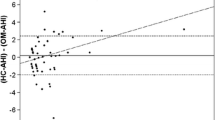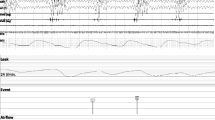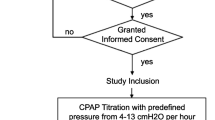Abstract
Purpose
Autotitrating continuous positive airway pressure (auto-CPAP) devices not only titrate CPAP pressures but also measure residual respiratory events. The aim of the present study was to determine the accuracy of auto-CPAP-derived residual apnea–hypopnea index (AHI).
Methods
We studied 137 consecutive patients (72.3% men) with obstructive sleep apnea from January 2008 to December 2010 who underwent in-laboratory overnight polysomnography (PSG) using auto-CPAP. We excluded patients with comorbidities like congestive heart disease, chronic obstructive pulmonary disease, or hypoventilation syndromes and patients with central sleep apnea. Residual AHI obtained from the auto-CPAP device by smart card (CPAP-AHI) was compared simultaneously with AHI from an overnight PSG on auto-CPAP (PSG-AHI) using Bland–Altman analysis and Wilcoxon signed-rank test.
Results
The mean AHI on the diagnostic study was 45.08 ± 1.8. During the titration, auto-CPAP markedly suppressed the respiratory events (PSG-AHI, 3.40 ± 0.20). On the other hand, CPAP-AHI was 3.35 ± 0.17. Bland–Altman analysis showed good agreement between auto-CPAP-AHI and PSG-AHI (AHI mean difference of 0.05, and the limits of agreement for the AHI were from +4.9 to −4.8). Two methods have also been compared with paired samples t test and no statistically significant difference was found (p > 0.05).
Conclusion
Auto-CPAP can identify residual respiratory events equivalent to the use of PSG in a selected population.


Similar content being viewed by others
Abbreviations
- OSA:
-
Obstructive sleep apnea
- auto-CPAP:
-
Autotitrating continuous positive airway pressure
- BMI:
-
Body mass index
- AHI:
-
Apnea–hypopnea index
References
Young T, Palta M, Dempsey J, Skatrud J, Weber S, Badr S (1993) The occurence of sleep-disordered breathing among middle-aged adults. N Engl J Med 328:1230–1235
Young T, Finn L, Peppard PE, Szklo-Coxe M, Austin D, Nieto FJ, Stubbs R, Hla KM (2008) Sleep disordered breathing and mortality: eighteen-year follow up of the Wisconsin sleep cohort. Sleep 31:1071–1078
Morgenthaler TI, Aurora RN, Brown T, Zak R, Alessi C, Boehlecke B, Chesson AL Jr, Friedman L, Kapur V, Maganti R, Owens J, Pancer J, Swick TJ, Standards of Practice Committee of the AASM (2008) Practice parameters for the use of autotitrating continuous positive airway pressure devices for titrating pressures and treating adult patients with obstructive sleep apnea syndrome: an update for 2007. An American Academy of Sleep Medicine report. Sleep 31:141–147
Iber C, Ancoli-Israel S, Chesson A, Quan SF (2007) The AASM manual for the scoring of sleep and associated events: rules, terminology, and technical specification, 1st edn. American Academy of Sleep Medicine, Westchester
Ueno K, Kasai T, Brewer G, Takaya H, Maeno K, Kasagi S, Kawana F, Ishiwata S, Narui K (2010) Evaluation of the apnea–hypopnea index determined by the S8 auto-CPAP, a continuous positive airway pressure device, in patients with obstructive sleep apnea–hypopnea syndrome. J Clin Sleep Med 6:146–151
Desai H, Patel A, Patel P, Grant BJB, Mador MJ (2009) Accuracy of autotitrating CPAP to estimate the residual apnea–hypopnea index in patients with obstructive sleep apnea on treatment with autotitrating CPAP. Sleep Breath 13:383–390
Woodson BT, Saurejan A, Brusky LT, Han JK (2003) Nonattended home automated continuous positive airway pressure titration: comparison with polysomnography. Otolaryngol Head Neck Surg 128:353–357
Gugger M (1997) Comparison of ResMed AutoSet (version 3.03) with polysomnography in the diagnosis of the sleep apnoea/hypopnoea syndrome. Eur Respir J 10:587–591
Bradley PA, Mortimore IL, Douglas NJ (1995) Comparison of polysomnography with ResCare Autoset in the diagnosis of the sleep apnoea/hypopnoea syndrome. Thorax 50:1201–1203
Rees K, Wraith PK, Berthon-Jones M, Douglas NJ (1998) Detection of apnoeas, hypopnoeas and arousals by the AutoSet in the sleep apnoea/hypopnoea syndrome. Eur Respir J 12:764–769
Kiely JL, Delahunty C, Matthews S, McNicholas WT (1996) Comparison of a limited computerized diagnostic system (ResCare Autoset) with polysomnography in the diagnosis of obstructive sleep apnoea syndrome. Eur Respir J 9:2360–2364
Mayer P, Meurice JC, Philip-Joet F, Cornette A, Rakotonanahary D, Meislier N, Pepin JL, Levy P, Veale D (1998) Simultaneous laboratory-based comparison of ResMed Autoset with polysomnography in the diagnosis of sleep apnoea/hypopnoea syndrome. Eur Respir J 12:770–775
Fleury B, Rakotonanahary D, Hausser-Hauw C, Lebeau B, Guilleminault C (1996) A laboratory validation study of the diagnostic mode of the Autoset system for sleep-related respiratory disorders. Sleep 19:502–505
Prasad B, Carley DW, Herdegen JJ (2010) Continuous positive airway pressure device-based automated detection of obstructive sleep apnea compared to standard laboratory polysomnography. Sleep Breath 14:101–107
Series F, Plante J, Lacasse Y (2008) Reliability of home CPAP titration with different automatic CPAP devices. Respir Res 9:56
Acknowledgments
This study was supported by the Akdeniz University Scientific Project Unit.
Conflict of interest
This was not an industry-supported study and the authors declare that they have no conflict of interest.
Author information
Authors and Affiliations
Corresponding author
Rights and permissions
About this article
Cite this article
Cilli, A., Uzun, R. & Bilge, U. The accuracy of autotitrating CPAP-determined residual apnea–hypopnea index. Sleep Breath 17, 189–193 (2013). https://doi.org/10.1007/s11325-012-0670-x
Received:
Revised:
Accepted:
Published:
Issue Date:
DOI: https://doi.org/10.1007/s11325-012-0670-x




